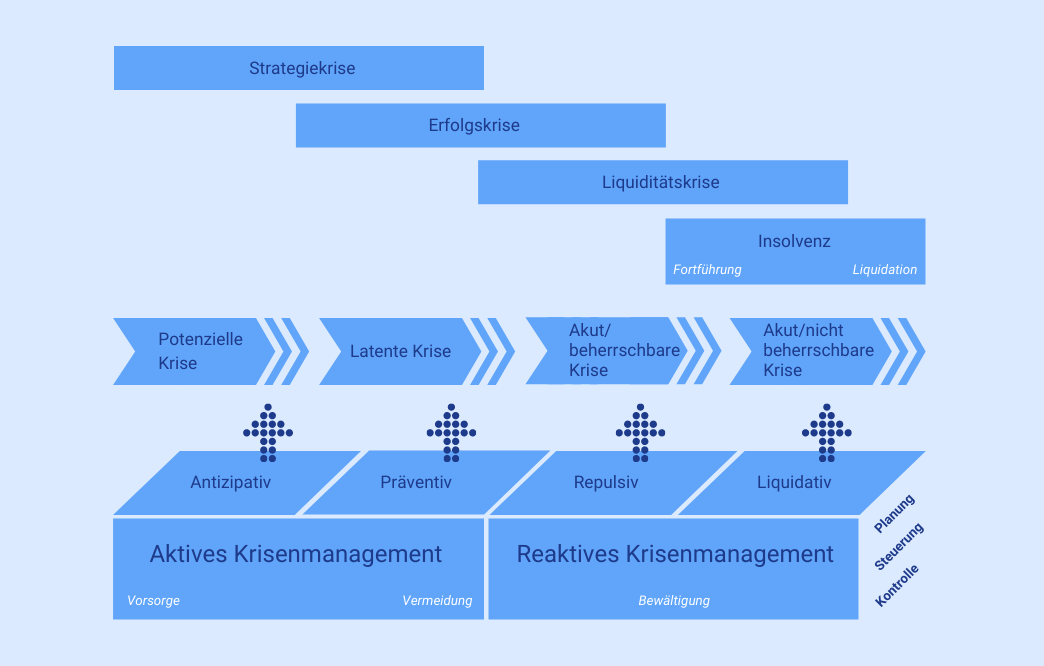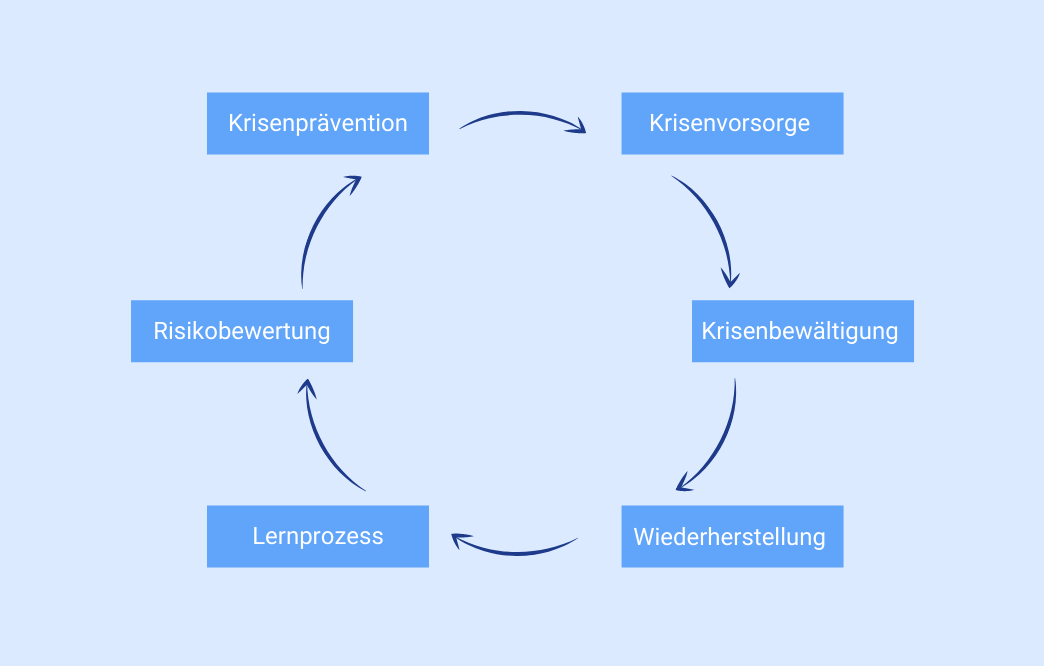Table of contents
A crisis is usually long-term and cannot be resolved quickly. However, one does not only speak of a crisis when, for example, a company has become insolvent, but also earlier when certain symptoms appear. And although there are clear signs that contribute to the emergence of a crisis, it is usually perceived as a surprise. Yet the symptoms can already be identified at certain stages of the crisis process. In the second part of our 8-part blog series, we will therefore look at the actual process of crisis management and the characteristic phases it goes through.
We will now clarify what these are.
The crisis management process
In its simplest version, the crisis management process consists of at least three phases before, during and after the crisis. Since in practice these phases cannot be divided into strict crisis management activities, but rather represent an overlap of different phases, the crisis management process is a continuous cycle. (Cf. Pursiainen, Christer. The Crisis Management Cycle. Taylor & Francis, 2017. [VitalSource Bookshelf]). Thus, the Federal Ministry of the Interior also sees crisis management as a cycle of preparedness, preparation, coping and follow-up, which has proven itself in practice and is explicitly recommended.
Let us now turn to two crisis management models that illuminate these stages in somewhat more detail, the four-phase model according to Ulrich Krystek and the crisis management cycle according to Christer Pursiainen.
Four-phase model according to U. Krystek
The crisis management process according to Ulrich Krystek deals with the appearance of the phases of the crisis process and how they can be influenced. It comprises the four phases potential corporate crisis, latent corporate crisis, acute/manageable corporate crisis and acute/non-controllable corporate crisis:
1. potential enterprise crisis: The first phase represents the emergence phase of the crisis. It is the quasi-normal state in which companies constantly find themselves, since possible crisis symptoms are not yet recognisable. This phase forms the starting point for the development of the crisis and the subsequent phases.
2. Latent corporate crisis: At this point, the crisis is already present, but is still hidden. The crisis therefore spreads undetected and develops slowly. The earlier a crisis is identified, the better this is for organisations and companies, of course. In this phase, however, the crisis can still be perceived, provided that one has a good and sensitive early warning system to detect crises in time.
3. acute/manageable business crisis: In this phase it is easier to recognise the crisis. Quick decisions have to be made now. Identifying the cause of the crisis and taking measures to stop the effects as quickly as possible are crucial here. At this point, managing a crisis is still possible, even if more and more resources are needed. If it is not possible to resolve the business crisis, the crisis process enters the final phase.
4. acute/unmanageable business crisis. In the final phase, the company’s goals can no longer be achieved and the company is no longer viable. Here, the demands of crisis management exceed the available potential for action. So if the company management has not been able to get a grip on the crisis in the previous phase, it has no choice but to accept the acute, unmanageable company crisis and its consequences.

The figure visualises the above-mentioned four phases of the basic crisis process and shows a further subdivision into active crisis management and reactive crisis management, which are characterised as follows:
Active crisis management: Active crisis management includes the stages of early crisis detection, crisis preparedness and crisis prevention, since no crisis is present here yet. Accordingly, the goal of active crisis management is to prevent the crisis. A distinction is made between two forms of active crisis management:
- Anticipatory crisis management: This is concerned with possible corporate crises that either have no effect on the company or only affect it in the future. The task of anticipatory crisis management is to avert the crisis, for example with the help of forecasts.
- Preventive crisis management: This involves the detection of hidden crises by means of an early warning system.
Reactive crisis management: Reactive crisis management includes the areas of crisis steering, crisis control and crisis follow-up. The crisis already exists and attempts are made to control and overcome it. The goal of reactive crisis management is therefore crisis control. Here, too, a distinction is made between two forms:
- Repulsive crisis management: This involves crises that have already occurred, but which can still be controlled with certain courses of action and can thus be brought back under control. This is also referred to as company-preserving crisis management.
- Liquidative crisis management This is an acute corporate crisis that can no longer be controlled. The company no longer has a chance of survival and is urged to take the orderly way back in order to protect itself from major losses.
Let us now turn to another model of crisis management:
The Crisis Management Cycle according to C. Pursiainen
In his book “The Crisis Management Cycle” (Cf. Pursiainen, Christer. ### The Crisis Management Cycle. Taylor & Francis, 2017. [VitalSource Bookshelf]), Christer Pursiainen, Professor of Societal Security at the University of Tromsø - Norway’s Arctic University, identifies six phases of crisis management that can be used for any type of organisation. Here, the three basic phases already mentioned (before the crisis, during the crisis and after the crisis) are divided into more detailed phases, namely: risk assessment, crisis prevention, crisis preparedness, crisis management, recovery and learning process:

The phases of the crisis management process in focus
An effective crisis management requires the efficient management of the individual phases. The advantage for this is that many of these phases have already been defined by international standards organisations or other international bodies. This applies in particular to the very practice-oriented areas of disaster preparedness and business continuity (/en/blog/business-continuity-management-als-hands-on-ansatz/), which can be applied to almost all areas of crisis management with certain adaptations.
What the individual phases focus on in detail and what they mean for companies and organisations you can read in the third part of this series.
Stay tuned, it’s worth it!

